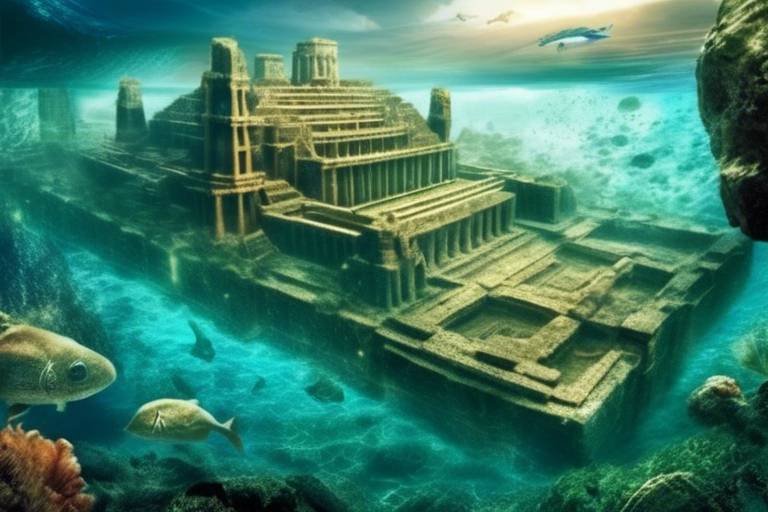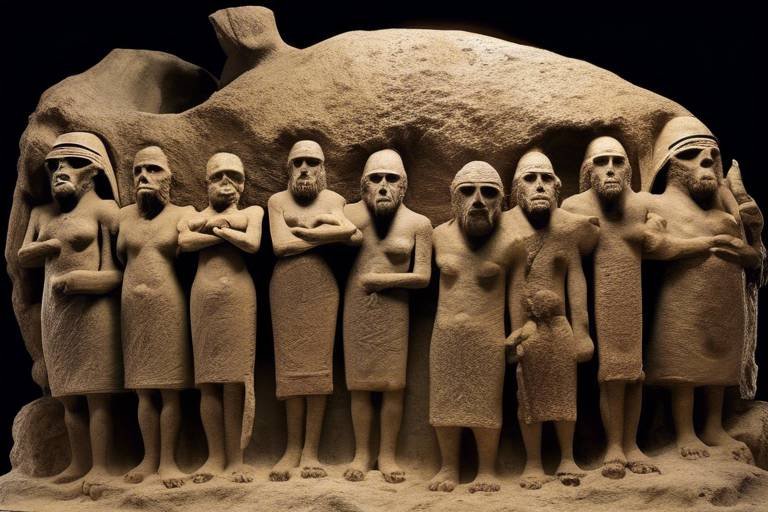The Mystery of the Lost Civilizations of Mesopotamia
Have you ever wondered about the ancient Mesopotamian civilizations that mysteriously vanished, leaving behind a trail of archaeological enigmas? The allure of exploring the enigmatic disappearance of these once-great societies beckons us to delve into the depths of history, unearthing the rich tapestry of culture and legacy they have left behind.

The Rise of Mesopotamian Civilizations
When we delve into the annals of history, the rise of Mesopotamian civilizations stands as a testament to human ingenuity and resilience. Mesopotamia, often referred to as the "cradle of civilization," witnessed the emergence of remarkable societies that laid the foundation for future advancements.
The Sumerians, with their sophisticated city-states and advanced irrigation systems, were among the first to flourish in this fertile land. Their innovations in writing, including the development of cuneiform script, revolutionized communication and record-keeping, shaping the course of history.
Following the Sumerians, the Akkadians, under the leadership of Sargon the Great, established the first empire in world history. Their military prowess and administrative skills paved the way for centralized rule and cultural exchange across Mesopotamia.
Subsequently, the Babylonians, with Hammurabi at the helm, created a powerful kingdom centered around the city of Babylon. The Code of Hammurabi, a comprehensive set of laws inscribed on a stele, reflected their commitment to justice and social order, leaving a lasting impact on legal systems worldwide.
Lastly, the Assyrians, known for their formidable military campaigns and architectural achievements, expanded their empire through conquest and strategic alliances. The grandeur of their capital city, Nineveh, and the imposing ziggurats symbolized their dominance in the region.
As these civilizations rose and fell, each contributing unique cultural, technological, and societal advancements, they collectively shaped the tapestry of Mesopotamian history, leaving an indelible mark on the world stage.

The Fall of Mesopotamian Empires
As we delve into the intriguing history of Mesopotamia, we cannot ignore the somber chapter that marks the fall of its once-mighty empires. The decline and eventual disappearance of these great civilizations were not a sudden event but rather a culmination of various factors that eroded their power and influence over time.
One of the primary reasons for the fall of Mesopotamian empires was the constant warfare and conflicts that plagued the region. The incessant battles for territorial control and resources weakened the empires, making them vulnerable to external threats and internal unrest. The relentless cycle of conquest and defeat ultimately took its toll on the once-prosperous civilizations.
Environmental changes also played a significant role in the downfall of Mesopotamian empires. The region's reliance on the Tigris and Euphrates rivers for irrigation and agriculture made them susceptible to the impact of natural disasters such as floods and droughts. These environmental challenges disrupted the food supply and economic stability of the empires, contributing to their eventual collapse.
Furthermore, the invasions by foreign powers further destabilized the Mesopotamian empires. The relentless attacks from neighboring regions and conquering armies weakened the once-proud civilizations, leading to the gradual disintegration of their political and social structures. The inability to repel these invasions effectively marked the beginning of the end for the Mesopotamian empires.
As we reflect on the fall of these ancient civilizations, we are reminded of the fragile nature of power and the impermanence of human achievements. The legacy of Mesopotamia serves as a cautionary tale, highlighting the importance of resilience, adaptability, and unity in the face of challenges that threaten the very foundations of society.

Archaeological Discoveries
Archaeological discoveries in Mesopotamia have unveiled a treasure trove of ancient artifacts and structures that offer a glimpse into the rich history of this region. Among the most notable finds is the Royal Tombs of Ur, a collection of lavish burial sites dating back to the Sumerian civilization. These tombs, adorned with intricate jewelry and artifacts, provide valuable insights into the funerary practices and beliefs of the ancient Mesopotamians.
Another remarkable discovery is the Ishtar Gate of Babylon, a grand entrance to the city adorned with vibrant glazed bricks depicting mythical creatures. This architectural marvel not only showcases the artistic prowess of the Babylonians but also serves as a testament to their reverence for deities such as Ishtar, the goddess of love and war.
Furthermore, the ancient city of Nineveh has yielded significant archaeological findings, including the remnants of massive palaces, temples, and defensive walls. Excavations in Nineveh have unearthed cuneiform tablets detailing the daily lives, religious practices, and administrative activities of the Assyrian Empire, shedding light on their advanced civilization.
These discoveries not only offer a window into the past but also pose intriguing questions about the social, political, and cultural dynamics of Mesopotamian societies. The meticulous excavation and preservation of these archaeological sites play a crucial role in piecing together the puzzle of the lost civilizations of Mesopotamia, allowing us to appreciate the legacy left behind by these ancient peoples.

The Code of Hammurabi
The Code of Hammurabi, a significant legal document from ancient Mesopotamia, stands as a remarkable testament to the governance and justice system of that era. Engraved on a stele, a large stone pillar, this code consists of 282 laws covering various aspects of daily life, including commerce, property rights, marriage, and criminal behavior. It aimed to establish justice, protect the weak from the strong, and ensure fairness in society. The laws were written in cuneiform script, the earliest form of writing, demonstrating the advanced level of civilization in Mesopotamia.
One of the key principles of the Code of Hammurabi was the concept of "an eye for an eye, a tooth for a tooth," reflecting the idea of proportional punishment. This principle aimed to maintain order and deter crime by ensuring that the punishment corresponded to the offense committed. The code also emphasized social hierarchy and prescribed different penalties based on the social status of individuals. It provided guidelines for resolving disputes and enforcing contracts, contributing to the stability and functioning of Mesopotamian society.
The Code of Hammurabi not only served as a legal framework but also reflected the values and beliefs of Mesopotamian culture. It highlighted the importance of honor, integrity, and respect for authority. The laws were displayed publicly to ensure transparency and accessibility to all citizens. Additionally, the code included provisions for protecting the rights of women, children, and slaves, although these groups had fewer rights compared to free men.
Hammurabi, the sixth king of the First Babylonian Dynasty, promulgated the code around 1754 BC, making it one of the earliest known written legal systems in history. The code's influence extended beyond Mesopotamia, inspiring later legal codes and systems in various civilizations. Its legacy can be seen in the principles of justice, equality, and accountability that continue to shape modern legal practices and ethical standards.

Mesopotamian Religion and Mythology
Mesopotamian religion and mythology were deeply intertwined with the daily lives and beliefs of the ancient people of this region. The Mesopotamians worshipped a pantheon of gods and goddesses, each associated with different aspects of life and nature. For example, Marduk, the patron deity of Babylon, was revered as the supreme god of the Mesopotamian pantheon. Ishtar, the goddess of love and war, held a prominent place in their religious practices. These deities were believed to influence various aspects of human existence, from fertility and harvest to warfare and protection.
One of the most famous literary works from Mesopotamia is the epic of Gilgamesh, which recounts the adventures of a legendary hero and his quest for immortality. This epic reflects the Mesopotamian worldview, exploring themes of mortality, friendship, and the search for meaning in life. The story of Gilgamesh also highlights the complex relationship between gods and humans, showcasing the belief in divine intervention and the consequences of defying the will of the gods.
The Mesopotamians engaged in elaborate religious rituals and ceremonies to honor their deities and seek their favor. Priests played a crucial role in mediating between the gods and the people, offering sacrifices, prayers, and performing sacred rites. Temples were built as sacred spaces dedicated to specific gods, where offerings were made and ceremonies held to ensure the well-being of the community.
In Mesopotamian mythology, the creation of the world and humanity was often depicted through stories of divine beings and cosmic battles. The Enuma Elish, the Babylonian creation myth, describes the formation of the universe through a series of conflicts between gods and the triumph of Marduk over chaos. These myths served to explain the origins of the world and natural phenomena, providing a framework for understanding the mysteries of existence.

Technological Advancements
The Mesopotamian civilizations were pioneers in various technological advancements that laid the foundation for future innovations. One of the most significant inventions was the development of writing systems, such as cuneiform script, which revolutionized communication and record-keeping. Imagine the awe-inspiring moment when the first symbols were pressed into clay tablets, unlocking the power of written language for generations to come. This breakthrough not only facilitated administrative tasks but also preserved literature, legal documents, and historical records for posterity.
Moreover, the Mesopotamians introduced the world to the wheel, a simple yet ingenious creation that transformed transportation and trade. Picture the bustling streets of ancient city-states with carts and chariots rolling smoothly along, enhancing the efficiency of commerce and travel. The wheel symbolized progress and innovation, symbolizing the ingenuity of Mesopotamian engineers and their practical approach to solving everyday challenges.
In addition to the wheel, Mesopotamian societies excelled in developing sophisticated irrigation systems to harness the power of the Tigris and Euphrates rivers for agricultural purposes. By constructing canals, dams, and levees, they transformed arid landscapes into fertile farmland, ensuring a stable food supply for growing populations. This mastery of water management not only sustained their civilization but also paved the way for future agricultural practices worldwide.
Furthermore, the Mesopotamians were renowned for their architectural achievements, notably the construction of monumental ziggurats that served as religious centers and administrative hubs. These towering structures, resembling stepped pyramids, showcased their advanced engineering skills and cultural significance. Imagine standing at the base of a ziggurat, marveling at the intricate brickwork and intricate designs that reflected the spiritual beliefs and social organization of ancient Mesopotamia.
Overall, the technological advancements of Mesopotamian civilizations were groundbreaking in shaping the course of human history. From the invention of writing and the wheel to the mastery of irrigation systems and architectural marvels, their innovations continue to inspire awe and admiration. By embracing creativity and ingenuity, the ancient Mesopotamians left a lasting legacy that resonates with modern society, reminding us of the enduring impact of technological progress on civilization.

Trade and Commerce
Trade and commerce played a pivotal role in the prosperity and development of ancient Mesopotamian civilizations. The region's strategic location between major trade routes facilitated the exchange of goods, ideas, and culture, contributing to the economic growth of city-states like Ur, Babylon, and Assyria. Mesopotamia's fertile lands along the Tigris and Euphrates rivers allowed for abundant agricultural production, enabling surplus goods to be traded both locally and internationally.
One of the most significant aspects of Mesopotamian trade was the use of rivers for transportation. The Tigris and Euphrates rivers served as vital waterways for the movement of goods, connecting different regions within Mesopotamia and beyond. This efficient transportation system not only facilitated trade but also fostered cultural exchange and the spread of technology and knowledge.
Moreover, the development of a sophisticated barter system and the use of standardized weights and measures in Mesopotamia enhanced commercial activities. Merchants engaged in long-distance trade, exchanging commodities such as grain, textiles, metals, and luxury items like precious stones and spices. The establishment of marketplaces and trade hubs in urban centers further boosted economic interactions and the growth of urban economies.
Trade relations with neighboring regions and distant lands, such as the Indus Valley civilization and Egypt, enriched Mesopotamian commerce. The exchange of goods like timber, copper, and lapis lazuli from distant sources demonstrates the extensive network of trade connections that Mesopotamian traders established. This cross-cultural trade not only stimulated economic prosperity but also facilitated cultural diffusion and the sharing of ideas and innovations.
In conclusion, trade and commerce were integral components of Mesopotamian civilization, driving economic growth, cultural exchange, and technological advancements. The thriving trade networks, efficient transportation systems, and vibrant marketplaces of ancient Mesopotamia laid the foundation for the region's economic prosperity and enduring legacy in the annals of history.

Legacy of Mesopotamian Civilization
The legacy of Mesopotamian civilization is deeply ingrained in the foundations of human progress, shaping various aspects of society that continue to influence us to this day. One of the most significant contributions of Mesopotamia is in the field of literature. The epic of Gilgamesh, a masterpiece of ancient storytelling, offers insights into human nature, mortality, and the quest for immortality. It serves as a timeless piece of literature that has inspired countless works of art and literature across different cultures.
In the realm of mathematics, Mesopotamia laid the groundwork for numerical systems, geometric principles, and mathematical calculations. The invention of the sexagesimal system, based on the number 60, revolutionized mathematical thinking and paved the way for advancements in astronomy, architecture, and trade. Mesopotamian mathematicians also made significant progress in areas such as algebra and geometry, setting the stage for future mathematical developments.
Furthermore, the ancient Mesopotamians were pioneers in astronomy, observing celestial phenomena and developing early astronomical theories. Their study of the stars, planets, and constellations not only influenced their religious beliefs and calendar systems but also laid the groundwork for future astronomical discoveries. The accurate tracking of celestial movements and the development of lunar calendars demonstrate the advanced knowledge and intellectual curiosity of Mesopotamian astronomers.
In the realm of governance, Mesopotamian civilizations established some of the earliest forms of centralized authority and legal systems. The Code of Hammurabi, a comprehensive set of laws and regulations, provided a framework for justice, social order, and accountability in ancient Mesopotamia. Its principles of "an eye for an eye" and "innocent until proven guilty" have influenced legal systems around the world and shaped the concept of justice in various societies.
Moreover, Mesopotamian innovations in architecture have left a lasting impact on the development of monumental structures and urban planning. The construction of ziggurats, massive stepped temples dedicated to deities, showcased the engineering prowess and religious devotion of Mesopotamian societies. These architectural marvels not only served as religious centers but also symbolized the power and grandeur of ancient city-states, influencing architectural styles in subsequent civilizations.
In conclusion, the legacy of Mesopotamian civilization is a testament to the ingenuity, creativity, and resilience of ancient societies that thrived in the cradle of civilization. Their contributions to literature, mathematics, astronomy, governance, and architecture have laid the foundation for human progress and continue to inspire and shape our modern world.
Frequently Asked Questions
- What were the major civilizations of Mesopotamia?
The major civilizations of Mesopotamia included the Sumerians, Akkadians, Babylonians, and Assyrians. Each of these civilizations made significant contributions to the region's history and culture.
- What led to the decline of Mesopotamian empires?
The decline of Mesopotamian empires was influenced by factors such as warfare, environmental changes, invasions by outside forces, and internal conflicts. These challenges ultimately contributed to the downfall of once-great civilizations.
- What are some notable archaeological discoveries in Mesopotamia?
Some notable archaeological discoveries in Mesopotamia include the Royal Tombs of Ur, the Ishtar Gate of Babylon, and the ancient city of Nineveh. These findings provide valuable insights into the ancient history and culture of the region.
- How did Mesopotamian civilizations impact future societies?
Mesopotamian civilizations had a lasting impact on future societies through their advancements in areas such as writing, mathematics, astronomy, and governance. Their innovations laid the foundation for future developments in these fields.



















